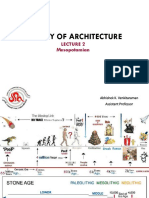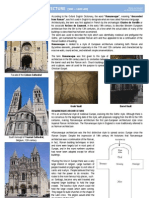100%(3)100% found this document useful (3 votes)
2K viewsWalter Gropius
Walter Gropius
Uploaded by
Abhishek Venkitaraman IyerWalter Adolph Gropius was a German American architect who founded the influential Bauhaus school in Germany. The Bauhaus promoted a functional, unified approach to design that combined art and technology. Gropius designed the Bauhaus school buildings in Dessau in 1925, which featured simplicity, glass walls, and an emphasis on transparency and absence of weight. The Bauhaus brought together artists and designers to develop goals for modern design by combining aesthetic concerns with new industrial materials and techniques.
Copyright:
Attribution Non-Commercial (BY-NC)
Available Formats
Download as PDF, TXT or read online from Scribd
Walter Gropius
Walter Gropius
Uploaded by
Abhishek Venkitaraman Iyer100%(3)100% found this document useful (3 votes)
2K views17 pagesWalter Adolph Gropius was a German American architect who founded the influential Bauhaus school in Germany. The Bauhaus promoted a functional, unified approach to design that combined art and technology. Gropius designed the Bauhaus school buildings in Dessau in 1925, which featured simplicity, glass walls, and an emphasis on transparency and absence of weight. The Bauhaus brought together artists and designers to develop goals for modern design by combining aesthetic concerns with new industrial materials and techniques.
Original Title
WALTER GROPIUS
Copyright
© Attribution Non-Commercial (BY-NC)
Available Formats
PDF, TXT or read online from Scribd
Share this document
Did you find this document useful?
Is this content inappropriate?
Walter Adolph Gropius was a German American architect who founded the influential Bauhaus school in Germany. The Bauhaus promoted a functional, unified approach to design that combined art and technology. Gropius designed the Bauhaus school buildings in Dessau in 1925, which featured simplicity, glass walls, and an emphasis on transparency and absence of weight. The Bauhaus brought together artists and designers to develop goals for modern design by combining aesthetic concerns with new industrial materials and techniques.
Copyright:
Attribution Non-Commercial (BY-NC)
Available Formats
Download as PDF, TXT or read online from Scribd
Download as pdf or txt
100%(3)100% found this document useful (3 votes)
2K views17 pagesWalter Gropius
Walter Gropius
Uploaded by
Abhishek Venkitaraman IyerWalter Adolph Gropius was a German American architect who founded the influential Bauhaus school in Germany. The Bauhaus promoted a functional, unified approach to design that combined art and technology. Gropius designed the Bauhaus school buildings in Dessau in 1925, which featured simplicity, glass walls, and an emphasis on transparency and absence of weight. The Bauhaus brought together artists and designers to develop goals for modern design by combining aesthetic concerns with new industrial materials and techniques.
Copyright:
Attribution Non-Commercial (BY-NC)
Available Formats
Download as PDF, TXT or read online from Scribd
Download as pdf or txt
You are on page 1of 17
WALTER ADOLPH GROPIUS
Walter Adolph Gropius was a German American
architect and educator, who founded the Bauhaus.
The Bauhaus was a German art school that became
a seminal force in architecture and applied art
during the first half of the 20th century.
His central thesis, which served as the school's
guiding principle, was that design (in any of its
forms) should be functional, based on a wedding of
art and engineering. This concept, expressed in his
own buildings, had a profound influence on modern
architecture.
Gropius was born in Berlin on May 18, 1883.
He studied architecture in Munich and Berlin-
Carlottenburg.
WALTER GROPIUS - THEORY OF DESIGN 1
After World War I he became director of two Weimar
art schools. Reorganizing them in 1919 as the
Staatliches Bauhaus (State Building School).
Here students received a basic crafts training to gain
an acquaintance with materials and processes.
This method, which led to a heightened awareness of
the realities of production, virtually revolutionized
modern design.
When the school was moved to Dessau in 1925,
Gropius designed its buildings. They are marked by
simplicity of shape, elimination of surface
decoration, and the extensive use of glass.
1938-52), he introduced the Bauhaus concepts and
helped to shape a generation of American architects.
Gropius died in Boston on July 5, 1969.
WALTER GROPIUS - THEORY OF DESIGN 2
Gropius introduced a new approach to design
education that emphasized the principle of uniting
art and technology.
He argued for the relative autonomy of fine and
applied art.
He expressed belief in the necessity for reuniting
aesthetic sensibility and utilitarian design. But there
was no mention of the design of types for mass
production .
It seemed as if it had returned to the roots of Arts
and Crafts movement, to William Morris , and to the
belief in handicraft as the sole viable guarantee of
design quality.
He advocated a workshop–based design education for
both design and craftsmen.
WALTER GROPIUS - THEORY OF DESIGN 3
He discovered the art form of the steel framed
structure
His walls show clearly that they no longer carry and
support the building. Instead the role of the wall was
restricted to mere screens, stretched between the
upright columns of the framework, to keep out rain,
cold and noise.
The use of glass walls presented and unusual
spectacle to eyes accustomed to the supporting wall.
He started the trend towards transparency and
absence of weight.
In the Bauhaus (1925-26), he developed the
organisation of large volumes of space.
Significantly, Gropius derived several of his design
ideas from the European publication of Frank Lloyd
Wright work . the courtyard side of the office block,
for example, relies in the elevation of the Mason city
).
hotel (1909 in Iowa).
WALTER GROPIUS - THEORY OF DESIGN 4
The Bauhaus - evolution of an idea
An approach to the vexing problem of industrial
production and artistic expression was proposed by
the founding of the Bauhaus.
The Bauhaus was formed by the fusion of two
existing institutions in Weimer: the old Academy of
Fine Arts and School of Applied Arts founded under
Van De Velde in 1906.
It was the outcome of a continuous effort to reform
applied art education in Germany around the turn of
the century.
It was founded with visions of erecting the cathedral
of socialism and the workshops were established in
the manner of cathedral building lodges.
It became a center for artists trying to combine
aesthetic concerns with new industrial materials and
techniques, in what became known as the
International style.
WALTER GROPIUS - THEORY OF DESIGN 5
The bridging of the gulf between artistic forms and
industrial production was one of the chief motives of
the Bauhaus. They generally advocated simplicity of
form that was adapted to the object's function.
The Bauhaus brought together architects, painters,
and designers…to formulate goals for the modern
age.
It intended to encompass a wide range of creative
works including ceramics, weaving, painting,
architecture.
Parallel with these courses was the Formlehre (study
of form) – instruction in the basis of formal
arrangement, including composition and the study of
colour, texture, and expression .
Eventually these courses were best taught by men
like Paul Klee, Wassily Kandinsky and Oscar
Schlemmer.
WALTER GROPIUS - THEORY OF DESIGN 6
His works
The first major project of Gropies and Meyer, the
Fagus shoe last factory at Alfred an der Leine, is
considered a landmark in the history of modern
architecture.
It used elements that later characterized the
International Style.
Glass curtain walls between expressed steel
supports, corners left free of solid masonry, and
simple rectangular massing with a flat roof.
The front façade was windowless and clad with
limestone resembling brick.
Most important was architecture of the
administration block with its transparent staircase,
the glass waalled offices with cotinous round the
corners, and the roof terraces.
WALTER GROPIUS - THEORY OF DESIGN 7
This exemplary modern work was started in 1926 at
Dessau.
Gropius’s chief aim was to demarcate each element
quite distinctly without isolating one from another,
and at the same time to give an architectural unity
to the whole.
The plan of the building is a pinwheel reaching out
into space like a Mondrian painting.
He expressed elements as rectangular volumes of
varying sizes, linked by oblongs containing corridors
or smaller rooms.
The lightness of the building is emphasized by glass
curtain walls, that are drawn around the corner of
the building.
These glass walls flow into one another precisely at
the point where the human eye is accustomed to see
a supporting column.
WALTER GROPIUS - THEORY OF DESIGN 8
The interplay of transparency and the piercing the
space by bridges leads to an interpenetration of
horizontal and vertical planes. This makes it possible
to grasp the whole of the complex from any single
viewpoint.
The Bauhaus complex has no definite frontal façade
Gropius varied his fenestration to accentuate the
largeness or smallness of spaces within, and to admit
various qualities of light according to function.
The glass was laid flush with the facade, reinforcing
the overall volumetric character of a space enclosed
by a skin; at times it was recessed accentuating the
hovering white horizontal floor planes.
WALTER GROPIUS - THEORY OF DESIGN 9
Gropius’s most unequivocal work was his “Total
Theatre” project.
It was largely designed to satisfy the
requirements of a biomechanical stage to
provide the space for ‘theatre of action’.
Walter Gropius realized that the theatre should
create a form of life, which transforms the
passive spectator into active participant.
The auditorium should be kept permanently
illuminated, a permanent visual link thus
maintained between actor and audience.
WALTER GROPIUS - THEORY OF DESIGN 10
The objective is to create a great and flexible
instrument which can respond in terms of light and
space to every requirement of the theatre producer
giving his imagination a full play
The shape of the theatre is oval, with two
semicircular turntables touching it tangentially .
The theater makes it possible for the actors to play
during the same performance upon a proscenium
stage, apron stage or within a central arena or all
three simultaneously.
The auditorium is supported upon 12 slender
columns.
Screens are stretched between the 12 columns upon
which 12 films can be projected from the cameras
situated behind them.
WALTER GROPIUS - THEORY OF DESIGN 11
WALTER GROPIUS - THEORY OF DESIGN 12
Gropius had taken greater interest in the
prefabrication of houses than any other pioneers of
contemporary architecture.
A new building material was introduced in Germany
ferroconcrete which was applied for larger and
daring structures.
The concept behind prefabrication was that mass
productions methods could be employed which could
be cheaper and result in lower rent.
Gropius produced on the site certain prefabricated
parts, such as standardized beams of reinforced
concrete and cinder blocks for supporting cross walls.
WALTER GROPIUS - THEORY OF DESIGN 13
Prefabricated housing projects include the
Weissenhof Housing based on dry construction
using light steel framework, with wall panels of
compressed cork covered with sheets of asbestos
cement.
The packaged House System used wood framed
panels which cladding of narrow boards of same
material .
Here every element was based upon the same
module 3 feet 4 inches. The length of the panels
were multiple of this dimension.
These panels could be assembled horizontally or
vertically to form floors, walls, ceilings or roof,
which was possible through four way steel joint or
connector.
WALTER GROPIUS - THEORY OF DESIGN 14
Gropius was interested in the design of large
complexes rather than individual houses.
A few houses exist, the first of historic
importance being those he designed for
members of teaching staff of the Bauhaus in
1925-26.
There were altogether four buildings: one
detached house for Gropius and three
duplexes (semi detached) for other staff
members.
The special needs of an artist’s dwelling
such as north-facing studio, were also taken
into account: staircase, kitchen, bathroom
facing north and the bedrooms and living
facing south.
The house Gropius built for himself stand on
the crest of a hill in the midst of apple
orchard
WALTER GROPIUS - THEORY OF DESIGN 15
The structure of the house consists of
traditional light wood frame of England,
sheathed with white painted clapboard
siding.
Rough fieldstone walls, like those
employed in seaside houses.
The big front porch, have given a new
spatial significance.
The projecting canopy, spiral staircase
and wooden trellis break up the compact
solid of the house form.
WALTER GROPIUS - THEORY OF DESIGN 16
bibliography
Walter Gropius -by Giedion, Sigfried
A World History Of Architecture
Modern Architecture since 1900 -by Curtis, William J.R.
Modern Architecture -by Frampton, Kenneth
Encarta Encyclopedia
WALTER GROPIUS - THEORY OF DESIGN 17
You might also like
- Ifa: A Complete Divination by Ayo Salami Book: Download HereDocument3 pagesIfa: A Complete Divination by Ayo Salami Book: Download HereKleiton Pinha0% (4)
- Survey and Analysis Techniques in Urban DesignDocument39 pagesSurvey and Analysis Techniques in Urban DesignAbhishek Venkitaraman Iyer93% (70)
- Survey and Analysis Techniques in Urban DesignDocument39 pagesSurvey and Analysis Techniques in Urban DesignAbhishek Venkitaraman Iyer93% (70)
- Analysis of Company, Products and Competitors of Vishal Mega MartDocument55 pagesAnalysis of Company, Products and Competitors of Vishal Mega Martaleyateeq100% (2)
- Contemporary ArchitectureDocument25 pagesContemporary ArchitectureShrishank RudraNo ratings yet
- Bauhaus ArchitectureDocument22 pagesBauhaus ArchitecturevijayaratnaNo ratings yet
- Expressionist Architecture-Deutsche Werkbund PDFDocument9 pagesExpressionist Architecture-Deutsche Werkbund PDFenistenebimNo ratings yet
- The Beginning of Modern Architecture - Boundless Art HistoryDocument14 pagesThe Beginning of Modern Architecture - Boundless Art HistorySanderNo ratings yet
- Richard Meier: Contemporary ArchitectureDocument40 pagesRichard Meier: Contemporary ArchitectureNarendra SimhaNo ratings yet
- Morphological Dimension of Urban DesignDocument107 pagesMorphological Dimension of Urban DesignAbhishek Venkitaraman Iyer100% (8)
- The Functional Dimension of Urban DesignDocument103 pagesThe Functional Dimension of Urban DesignAbhishek Venkitaraman Iyer86% (7)
- Mesopotamian ArchitectureDocument79 pagesMesopotamian ArchitectureAbhishek Venkitaraman Iyer100% (3)
- Egyptian Town PlanningDocument43 pagesEgyptian Town PlanningAbhishek Venkitaraman Iyer96% (24)
- Prehistoric ArchitectureDocument84 pagesPrehistoric ArchitectureAbhishek Venkitaraman Iyer100% (3)
- Mesopotamian Town PlanningDocument56 pagesMesopotamian Town PlanningAbhishek Venkitaraman Iyer91% (45)
- Baroque Town PlanningDocument14 pagesBaroque Town PlanningAbhishek Venkitaraman Iyer96% (27)
- The Tamil Nadu Town & Country Planning Act, 1971Document19 pagesThe Tamil Nadu Town & Country Planning Act, 1971Abhishek Venkitaraman IyerNo ratings yet
- Egypt Greece & Mesopotamian Town PlanningDocument44 pagesEgypt Greece & Mesopotamian Town PlanningAbhishek Venkitaraman Iyer82% (11)
- Application Selection Certificate QuebecDocument9 pagesApplication Selection Certificate QuebecsudokuNo ratings yet
- 2 Effective Business Communication Final Exam Format Rev Dated Feb 15 2020Document7 pages2 Effective Business Communication Final Exam Format Rev Dated Feb 15 2020Gurlal SinghNo ratings yet
- On Works of Walter Gropius and His BuildingsDocument19 pagesOn Works of Walter Gropius and His BuildingsnandantharejaNo ratings yet
- Walter GropiusDocument15 pagesWalter GropiusloveenaNo ratings yet
- Walter GropiusDocument23 pagesWalter GropiusKaunda Lembalemba100% (1)
- Walter GropiusDocument11 pagesWalter GropiusseeratNo ratings yet
- History of Furniture StylesDocument40 pagesHistory of Furniture StylesAdinaNo ratings yet
- Seagram Building ......Document20 pagesSeagram Building ......samNo ratings yet
- Charles MooreDocument37 pagesCharles MooreRounak GodhkeyNo ratings yet
- Arts and Crafts Movement, Red HouseDocument9 pagesArts and Crafts Movement, Red HouseKavyaNo ratings yet
- INTD402 Furniture, Fittings, Textile & AcessoriesDocument34 pagesINTD402 Furniture, Fittings, Textile & AcessoriesAmr MohamedNo ratings yet
- Adolf LoosDocument23 pagesAdolf LoosJACKULIN DAFNEENo ratings yet
- LECTURE 9 - DE STIJL and EXPRESSIONISM ARCHITECTUREDocument22 pagesLECTURE 9 - DE STIJL and EXPRESSIONISM ARCHITECTUREIzzul FadliNo ratings yet
- AssignmentDocument12 pagesAssignmentAtharva ParteNo ratings yet
- Chicago School Louis SullivanDocument19 pagesChicago School Louis SullivanKumar SatyamNo ratings yet
- Romanesque Architecture WWW - SamueldichosoDocument13 pagesRomanesque Architecture WWW - SamueldichosoSam_Dichoso_4540No ratings yet
- PostmodernismDocument18 pagesPostmodernismPREETHI M ANo ratings yet
- Landscape DesignDocument15 pagesLandscape DesignsaimaNo ratings yet
- Richard MeierDocument26 pagesRichard MeierHassan JaseemNo ratings yet
- Art Nouveau and Art DecoDocument16 pagesArt Nouveau and Art DecoHarshit AroraNo ratings yet
- Frank o GehryDocument17 pagesFrank o GehryChania BhatiaNo ratings yet
- Mies Van Der Rohe WorksDocument34 pagesMies Van Der Rohe WorksAshish HoodaNo ratings yet
- Ornamentation in ArchitectureDocument6 pagesOrnamentation in ArchitecturePoorvi M PNo ratings yet
- Purism: Submitted By: Domingo, Angelo Jose Gutierrez, Joseph Kirk Nikolo Madriaga, Michelle Angelika Tayaban, NellbvezzDocument19 pagesPurism: Submitted By: Domingo, Angelo Jose Gutierrez, Joseph Kirk Nikolo Madriaga, Michelle Angelika Tayaban, NellbvezzJay Domingo100% (1)
- Modern ArchitectureDocument5 pagesModern ArchitectureJireh GraceNo ratings yet
- Ludwig Mies Van Der RoheDocument18 pagesLudwig Mies Van Der RoheDhwani AntalaNo ratings yet
- Post War Decades-International StyleDocument41 pagesPost War Decades-International StyleGaurika Grover100% (2)
- Indian ArchitectsDocument27 pagesIndian ArchitectsSharvari MateNo ratings yet
- 21st Century Contemporary ArchitectureDocument30 pages21st Century Contemporary ArchitectureShahab SaquibNo ratings yet
- Ludwig Mies Van Der RoheDocument11 pagesLudwig Mies Van Der RoheManthan KirdatNo ratings yet
- Issues of Ornamentation and AestheticsDocument70 pagesIssues of Ornamentation and AestheticsFatema SugraNo ratings yet
- Precedent StudyDocument37 pagesPrecedent StudyAlizeyh AliNo ratings yet
- Frank O. Gehry: BY:-Mohd Shanwez Jamal B.Arch 6 SEMDocument28 pagesFrank O. Gehry: BY:-Mohd Shanwez Jamal B.Arch 6 SEMANSHIKA SINGHNo ratings yet
- Compact Courtyard HousingDocument21 pagesCompact Courtyard HousingRana MahfoodhNo ratings yet
- The Chicago SchoolDocument47 pagesThe Chicago SchoolOnyango OkeloNo ratings yet
- Ludwig Mies Van Der RoheDocument10 pagesLudwig Mies Van Der RoheshawulNo ratings yet
- Victor Horta's Power PointDocument17 pagesVictor Horta's Power Pointkaulanigurl2100% (2)
- The Principle of Unity in ArchitectureDocument6 pagesThe Principle of Unity in Architecturecarl_bautista_30% (1)
- Richard Meier PDFDocument2 pagesRichard Meier PDFSrujan Anand GajjalaNo ratings yet
- Case Study Adaptive ReuseDocument7 pagesCase Study Adaptive Reusesharvani kbNo ratings yet
- Greek Arch - Ist ModDocument42 pagesGreek Arch - Ist ModSohanNo ratings yet
- A Case Study of Pantheon PDFDocument3 pagesA Case Study of Pantheon PDFVan ValentinoNo ratings yet
- History I.M.PeiDocument26 pagesHistory I.M.PeiVedasri RachaNo ratings yet
- Importance & Evolution of Furniture: - Interior DesignDocument17 pagesImportance & Evolution of Furniture: - Interior Designnishita7sreeNo ratings yet
- Structural System StudyDocument11 pagesStructural System StudyShreya sinha100% (1)
- INTERIOR DESIGN in Western ContextDocument21 pagesINTERIOR DESIGN in Western ContextAgneyi BalluNo ratings yet
- Frank O Gehry: Contemporary Architectural Theory and PracticeDocument38 pagesFrank O Gehry: Contemporary Architectural Theory and PracticeGreety Maria Thomas100% (1)
- Walter GropiusDocument26 pagesWalter GropiusVibhor YadavNo ratings yet
- Neoclassical ArchitectureDocument28 pagesNeoclassical ArchitectureAvinash dixitNo ratings yet
- Antonio GaudiDocument13 pagesAntonio GaudiEkta Agarwal100% (1)
- Organic ArchitectureDocument7 pagesOrganic ArchitectureVickter LimNo ratings yet
- Engineers India House: Bhikaji Cama Bazaar, New Delhi, 1978Document13 pagesEngineers India House: Bhikaji Cama Bazaar, New Delhi, 1978Himani Sharma50% (2)
- Georgian ArchitectureDocument23 pagesGeorgian ArchitectureZhori DuberryNo ratings yet
- Carpenter Center For The Visual Arts, Le CorbusierDocument2 pagesCarpenter Center For The Visual Arts, Le CorbusierMihaela AvadaniiNo ratings yet
- The senses in interior design: Sensorial expressions and experiencesFrom EverandThe senses in interior design: Sensorial expressions and experiencesNo ratings yet
- The Architecture of Influence: The Myth of Originality in the Twentieth CenturyFrom EverandThe Architecture of Influence: The Myth of Originality in the Twentieth CenturyNo ratings yet
- The Visual Dimension of Urban DesignDocument107 pagesThe Visual Dimension of Urban DesignAbhishek Venkitaraman Iyer80% (10)
- Introduction To Urban DesignDocument46 pagesIntroduction To Urban DesignAbhishek Venkitaraman Iyer100% (9)
- Greek ArchitectureDocument121 pagesGreek ArchitectureAbhishek Venkitaraman Iyer67% (3)
- Town Planning & Urban Design HistoryDocument83 pagesTown Planning & Urban Design HistoryAbhishek Venkitaraman Iyer83% (6)
- Ghaziabad District DataDocument70 pagesGhaziabad District DataAbhishek Venkitaraman Iyer100% (1)
- Principles of Urban Design: Abhishek K. Venkitaraman Iyer Assistant Professor Faculty of Architecture, MITDocument31 pagesPrinciples of Urban Design: Abhishek K. Venkitaraman Iyer Assistant Professor Faculty of Architecture, MITAbhishek Venkitaraman Iyer100% (9)
- Ghaziabad District DataDocument70 pagesGhaziabad District DataAbhishek Venkitaraman Iyer100% (1)
- Ancient Egyptian ArchitectureDocument87 pagesAncient Egyptian ArchitectureAbhishek Venkitaraman Iyer100% (2)
- Rural Development Programs in IndiaDocument53 pagesRural Development Programs in IndiaAbhishek Venkitaraman Iyer100% (3)
- Losch TheoryDocument19 pagesLosch TheoryAbhishek Venkitaraman Iyer91% (11)
- Introduction To Human Settlements and Urban Form DeterminantsDocument84 pagesIntroduction To Human Settlements and Urban Form DeterminantsAbhishek Venkitaraman Iyer100% (44)
- Ghaziabad Zoning RegulationsDocument20 pagesGhaziabad Zoning RegulationsAbhishek Venkitaraman IyerNo ratings yet
- Ghaziabad ReviewDocument69 pagesGhaziabad ReviewAbhishek Venkitaraman IyerNo ratings yet
- Analysis of Physical Infrastructure of Roorkee TownDocument31 pagesAnalysis of Physical Infrastructure of Roorkee TownAbhishek Venkitaraman Iyer100% (3)
- Garden CityDocument7 pagesGarden CityAbhishek Venkitaraman IyerNo ratings yet
- Operation Flood:White Revolution of IndiaDocument6 pagesOperation Flood:White Revolution of IndiaAbhishek Venkitaraman Iyer100% (3)
- Indus Valley CivilizationDocument13 pagesIndus Valley CivilizationAbhishek Venkitaraman IyerNo ratings yet
- The Early UtopiaDocument22 pagesThe Early UtopiaAbhishek Venkitaraman IyerNo ratings yet
- The Hindu Marriage Act, 1955Document15 pagesThe Hindu Marriage Act, 1955Abhishek Venkitaraman IyerNo ratings yet
- The SHL Universal Competency Framework: January 2006Document12 pagesThe SHL Universal Competency Framework: January 2006Qingyi LiuNo ratings yet
- Cambridge IGCSE: English As A Second Language 0510/13Document16 pagesCambridge IGCSE: English As A Second Language 0510/13Ahmad RufaiNo ratings yet
- Wikipedia Marketing Book PDFDocument208 pagesWikipedia Marketing Book PDFRiz DeenNo ratings yet
- Operators Information Transmission - Oit: Customer Services DirectorateDocument5 pagesOperators Information Transmission - Oit: Customer Services DirectorateIbrahim KhalilNo ratings yet
- Abhay KumarDocument2 pagesAbhay KumarOM Prakash ChandraNo ratings yet
- TAX2 - ReportDocument6 pagesTAX2 - ReportJollibee Bida BidaNo ratings yet
- B. Possible: Practice Test 10 I. Choose The Best OptionDocument8 pagesB. Possible: Practice Test 10 I. Choose The Best OptionMai LêNo ratings yet
- Émile Benveniste "Subjectivity in Language" (1958) : Richard L. W. Clarke LITS3304 Notes 02BDocument5 pagesÉmile Benveniste "Subjectivity in Language" (1958) : Richard L. W. Clarke LITS3304 Notes 02Bholt.parker4072No ratings yet
- SBAR Article v2 - Mei 2013Document3 pagesSBAR Article v2 - Mei 2013Vidya NatawidhaNo ratings yet
- SVLF (La Fria) : General InfoDocument2 pagesSVLF (La Fria) : General InfoisaacvoxNo ratings yet
- Multimedia JournalismDocument2 pagesMultimedia JournalismTrooper_231No ratings yet
- Paces Membership FormDocument2 pagesPaces Membership FormVencint Karl TacardonNo ratings yet
- List of Journals With Article Processing Charges (APC) - 2Document13 pagesList of Journals With Article Processing Charges (APC) - 2Habtemariam A. KefaleNo ratings yet
- Samson v. RestriveraDocument3 pagesSamson v. RestriveraKarla BeeNo ratings yet
- Koha Digest 63 (1995)Document22 pagesKoha Digest 63 (1995)palacios_jmNo ratings yet
- Organizing Your Life PresentationDocument11 pagesOrganizing Your Life PresentationMakarima Fahreza Fathony100% (1)
- Performance AppraisalDocument43 pagesPerformance Appraisalamn_thkrNo ratings yet
- Effectiveness of Digital Tools Towards The Academic Performance of Senior High School Students of Green Fields Integrated School of LagunaDocument76 pagesEffectiveness of Digital Tools Towards The Academic Performance of Senior High School Students of Green Fields Integrated School of LagunaKanor DalisayNo ratings yet
- Children's Rights LeafletDocument2 pagesChildren's Rights LeafletDoodah2No ratings yet
- CPS 2006 3 HighDocument23 pagesCPS 2006 3 HighPatrickBooker100% (1)
- Gender EqualityDocument5 pagesGender Equalitynatassayannakouli100% (1)
- Ricafrente, Angela L. FS1 CED-02-601P Prof. Susan DominguezDocument4 pagesRicafrente, Angela L. FS1 CED-02-601P Prof. Susan DominguezLady Valerie Golpo88% (8)
- Lecture NotesDocument1 pageLecture Notessatishbojjawar14840% (1)
- A Student Manual On JurisprudenceDocument414 pagesA Student Manual On Jurisprudenceel kitime83% (6)
- Individual Incentive PlansDocument17 pagesIndividual Incentive PlansJojis JosephNo ratings yet
- Governance, Business Ethics, Risk Management and Control: GGSRDocument15 pagesGovernance, Business Ethics, Risk Management and Control: GGSRLysss EpssssNo ratings yet





















































































































